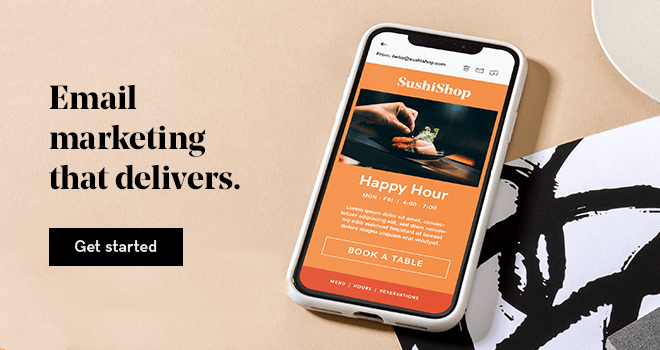Testimonials are an essential part of the customer journey—people are "270 percent more likely" to purchase a product with five reviews than one with no reviews.
Why is this the case? Consumers are skeptical about the information that companies share, as they know that the ultimate goal is to sell them something.
Customer testimonials, on the other hand, are unbiased reviews or recommendations written by their peers and, therefore, are much more trustworthy. They take away some of the hesitations a customer might have about making a purchase and, thereby, make it easier for them to come to a decision.
So if you can harness the power of testimonials in your email marketing, you just might see them lead to more conversions—if you use them correctly.
Here are seven ways you can incorporate testimonials into your emails in order to build trust, leverage social proof, and, ultimately, drive more conversions.
7 ways to use customer testimonials in your emails
1. Incorporate short product reviews
The best testimonials are punchy. Your email subscribers are unlikely to spend their precious time reading long reviews; they want to get a quick opinion on a product, not read War and Peace. At best, potential customers might scan a long review—which means they won’t take in the key message you, or the reviewer, is trying to communicate. Reviews should be compelling and get to the point quickly. Take a look at this example from Oros:
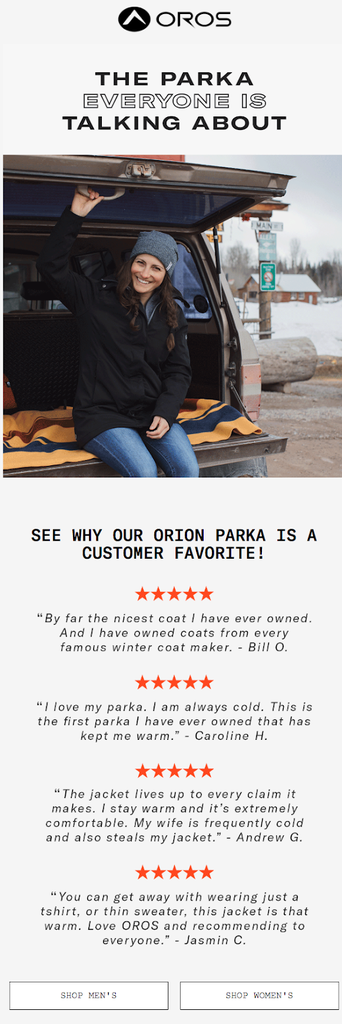
Via: Really Good Emails.
These reviews convey key messages about the brand and product in a short amount of time:
- Their parka beats other brands.
- Their parka is superior at keeping you warm.
- You can trust what this company says about its products because customers are saying the exact same things.
You could do something similar by considering your key value propositions and finding testimonials that best represent them; it’s more believable and impactful to have customers share this information than making such bold claims yourself. Also, as in the above example, you should use reviews that mention specific details about your products, to show your customer precisely the kind of benefits and value they can expect.
To source your reviews, you can simply pull them from the web, whether it’s your own eCommerce site, social media, or credible review sites like TrustPilot:
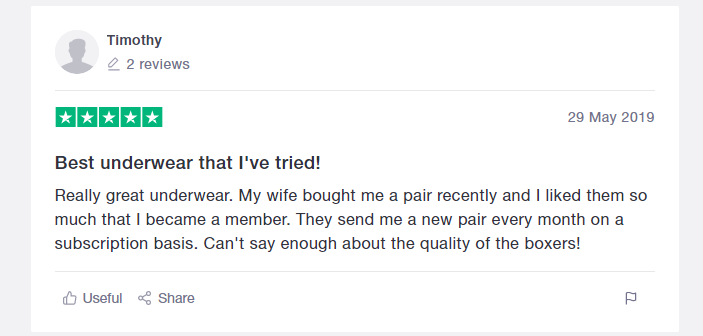
You can also ask for reviews via email. Just remember that a good testimonial is short, direct and product-specific—don’t be afraid to pick out one relevant, punchy line from a longer review.
2. Utilize user-generated content
User-generated content, or UGC as the cool kids call it, is hugely effective for eCommerce sites—79 percent of people say UGC highly impacts their purchase decisions, while only 13 percent say that content from brands impacts their decisions.
While customer testimonials are considered user-generated content, you can and should take it a step further, and incorporate customers’ social media posts, images, or video to enhance the impact of customer testimonials. That doesn’t just add credibility and authenticity to the reviews. UGC increases engagement as it encourages customers to get involved in your campaign and makes your brand relatable as customers see images of people like them using your product.
Here, Harry’s spotlights social media posts about their razors in the footer of an email.
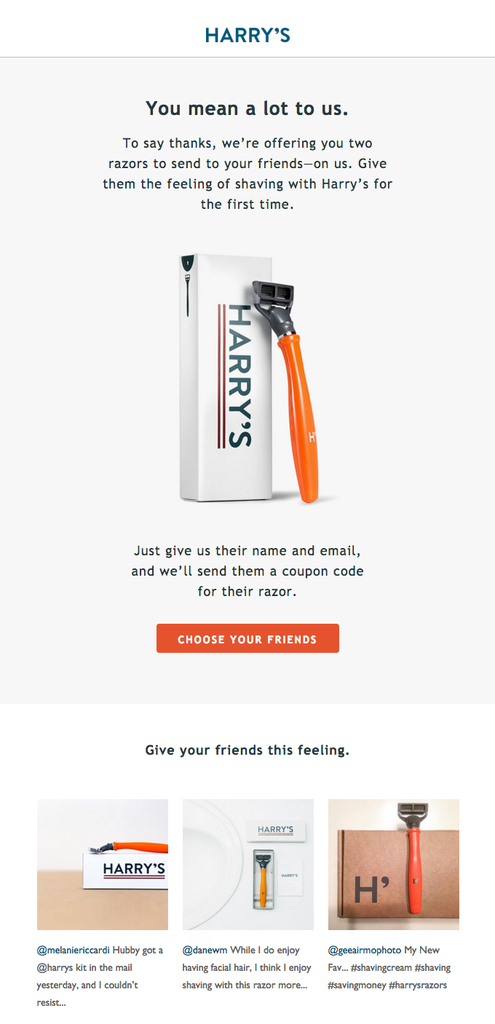
Via: Really Good Emails.
The authenticity here is off the charts—these are real people using slang and making witty comments.
This example also shows that testimonials along with UGC are perfect for referral campaigns. It engages the recipient, so they want to get involved and get their pals in on the action too.
Naturally, social media is an ideal place to source user-generated content for your emails (just be sure to get permission from customers before using their posts). Alternatively, you can create a campaign to encourage users to create and share images of themselves using your products. Create a unique hashtag that customers can use on Instagram and the like. ASOS, for example, uses the hashtag #asseenonme:
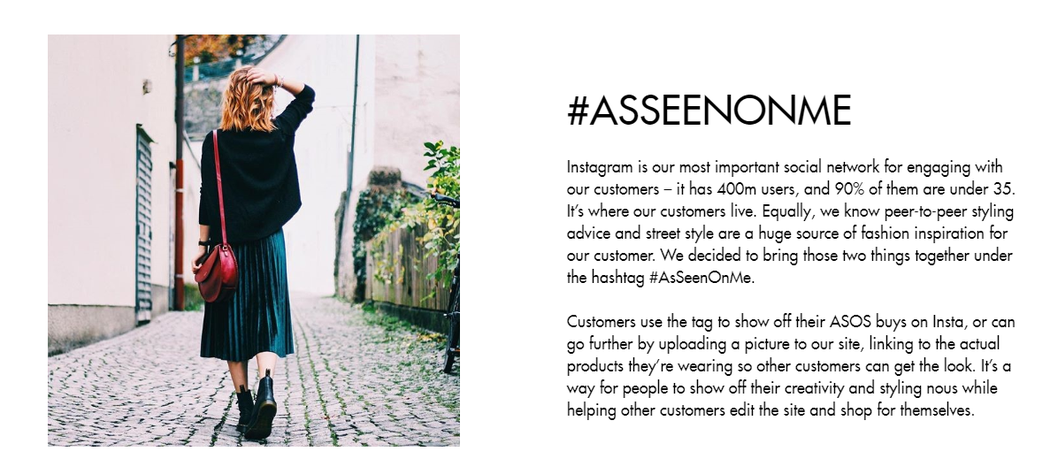
The key takeaway here is to use customer images and posts alongside testimonials. It adds authenticity and makes the products featured in your emails even more appealing.
3. Send video testimonials
Video is widely used in email marketing these days. Which is good, as 68 percent of people say they would prefer to learn about a new product or service by watching a short video. So, by including video in your emails, you know you’re going to make your subscribers happy. And rather than creating promotional videos all the time, you can add a human touch by using video testimonials from real customers.
Here, Trunk Club uses a video testimonial effectively.
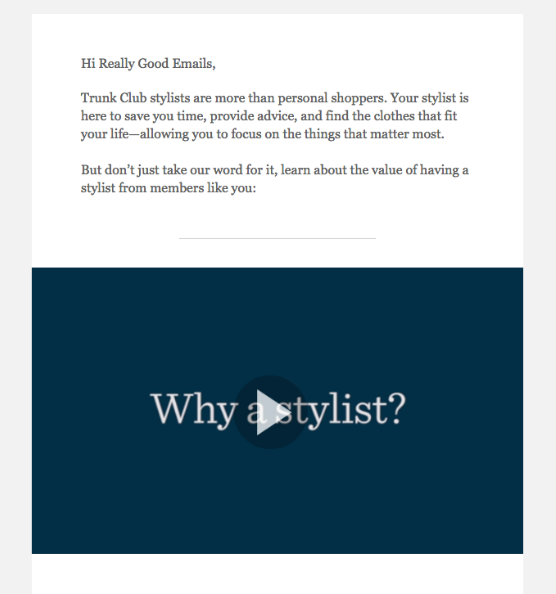
Via: Really Good Emails.
Their email copy epitomizes why video testimonials are so useful: “But don’t just take our word for it, learn about the value of having a stylist from members like you.” In other words, the video testimonial emphasizes the real-life benefits and results people get from their service (which the recipient could get too).
Through video you get to see enthusiastic people endorsing a product. You can use videos that you create and own like Trunk Club, or use YouTube. The platform is packed with product unboxing and review videos—people eat em’ up.
You may be able to share review videos uploaded by users with their permission. Or collaborate with influencers and have them create a video in which they provide an honest review your product. Either way, video is a great means of showcasing third parties who dig your product.
4. Share complete customer stories and case studies
Customer success stories and case studies are convincing. Not only do they evoke emotions, but they also give you the ability to show tangible results. Allie Decker at HubSpot says:
Stories help solidify abstract concepts and simplify complex messages. Taking a lofty, non-tangible concept and relating it using concrete ideas is one of the biggest strengths of storytelling in business.
In other words, you don’t just present an idea or the goal of your product… you turn fantasy into reality. This is an excellent example from online education platform, Masterclass.

Via: Really Good Emails.
The students in this story gained the opportunity of a lifetime by purchasing a Masterclass course. I don’t know about you, but I felt excited for those students. And that’s the whole point—to elicit an emotional response.
This type of email is perfect for when the customer is on the cusp of making a purchase. Customer success stories compel action, so approach loyal customers and ask for their stories. If you’re able to acquire data and/or images to support the story, it will be even more compelling.
But… it’s not always easy to get customers to share their stories. Make it as easy as possible for them to participate. Put together a list of simple questions for them to answer which you can later formulate into a story. You may also want to provide an incentive for taking part. Obviously, you can’t pay for reviews and expect them to be authentic. Instead, offer access to a special deal or entry to a competition.
When you’re done collecting stories, choose the most evocative to include in your campaigns.
5. Utilize testimonials to meet your goals
Testimonials must facilitate the objective of each email you send. There’s more to it than simply collecting a bunch of positive reviews: you need to make them work for you.
Your company no doubt sends lots of different types of email, from welcome emails to newsletters to post-purchase emails and so on. If you strike at the right moment with the right testimonial, then customers are more likely to buy.
Casper, for instance, uses testimonials intelligently in their abandoned cart recovery emails.
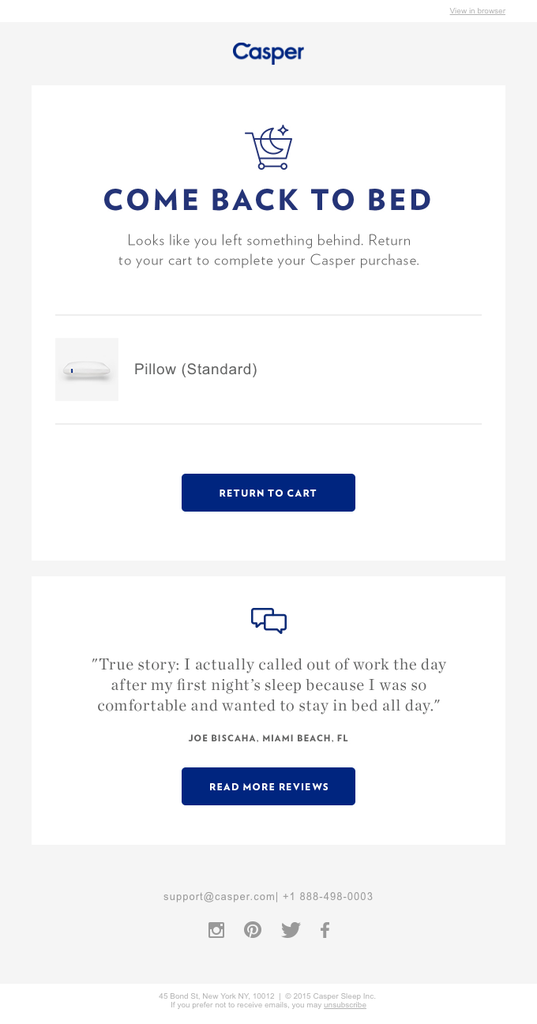
Via: Really Good Emails.
By including a compelling testimonial in an abandoned cart email, they’re aiming to address a customer’s cold feet in making the purchase. This testimonial takes away any doubts about the efficacy of the product.
Like Casper, think about how you can best use testimonials as part of your email marketing strategy.
For instance, share video or user-generated content created by early adopters when you have new products to encourage more people to get on board. Or send a product-specific review in a post-purchase email to reduce post-purchase dissonance, i.e. show the customer that made the right choice. All in all, you need to make sure testimonials match your objective and are used at the right time.
6. Personalize your use of testimonials
If personalization isn’t part of your email strategy, then you’re missing a trick. Ninety-eight percent of marketers believe that personalization advances customer relationships. And 78 percent use personalization in email, making it the most personalized marketing channel overall.
The best way to apply this tactic to your use of testimonials is by highlighting customers that belong to the demographic of recipients. The brand gets everything right. They feature a customer story made up of short, specific reviews and images of the customer wearing their products. And there’s a clear persona that they wish to target here, a busy, young entrepreneur and mom who’s into fashion.
You can emulate this by using testimonials from people that represent your target customers. Do you already have buyer personas in place? Amanda Marra at Business 2 Community says:
Making assumptions about your customers isn’t enough. It takes time and research to really figure out who your audience is. It is essential to examine common patterns in your audience.
So, create buyer personas by carefully researching your audience to figure out their demographics, pain points and desires.
If you want to personalize your emails even further, consider segmenting subscribers into groups. This is particularly effective if you sell a range of products catered to different types of users. You can separate them according to demographics, location, interests, purchase history and behaviors. Then send emails that feature the most fitting testimonial for each group.
The point is customers are more likely to engage with recommendations from people like them.
7. Combine with other forms of social proof
Share other forms of social proof alongside reviews to really drive the message home. Why does social proof work so well? Ben Johnson at IMPACT writes:
There are tons of ways to make money online, but by catering to the basic underwiring of human beings—with authenticity, social participation, and transparency—you’ll likely sell more and have customers that trust your site more in the long-run.
Social proof makes potential customers want to conform and get involved in something bigger. It adds to the credibility of your brand. And helps customers come to a decision that they’re confident about. Here, Duolingo incorporates an extra piece of social proof.

Via: Email Audience.
By stating that 350,000 teachers use Duolingo in the classroom this email elicits a reaction. It makes teachers think: Duolingo must be useful if so many others are using it. And: Am I putting my students at a disadvantage by not using Duolingo? That’s powerful.
As in the above example, data and numbers make for an irresistible form of social proof. Share how many products you have sold and in how many countries, for example. You can also use trust icons to prove your credibility. Display the logos of sites that have featured or reviewed your product. Similarly, celebrity or influencer endorsements have a lot of sway with customers.
The goal isn’t to overwhelm subscribers with social proof. But if you can provide extra social proof, as well as testimonials, in an email then it makes your offer rather convincing.
Key takeaways
Testimonials increase conversions as they help customers make the decision to buy. They should, therefore, be an integral part of your email marketing strategy.
- Keep them short. Short, direct reviews that contain specific details about the product in question work best.
- Utilize user-generated content and social proof. You can make the impact of testimonials even stronger through the use of video, user-generated content, and additional social proof like data.
- Share customer stories. Customer success stories and case studies elicit emotion in the reader and thereby encourage action.
- Pick the right testimonials. If you pair the right testimonials with the right emails, then you increase the likelihood of meeting your objectives.
- Personalized testimonials resonate. If you send emails to people with testimonials from customers matching their profile, those endorsements will resonate better.
Editor's note: This is a guest post from Emil Kristensen is the CMO and co-founder of Sleeknote, which helps eCommerce brands engage their site visitors.


